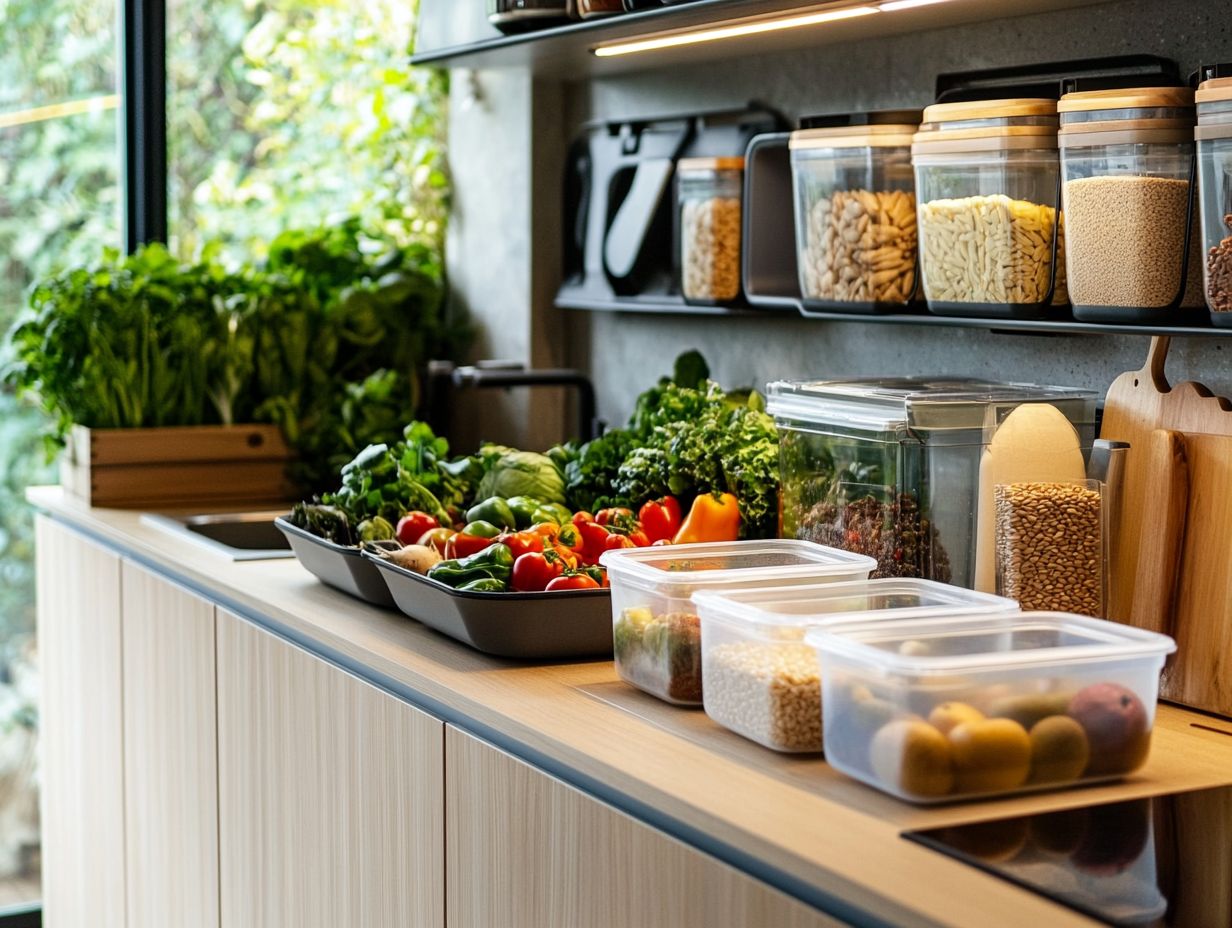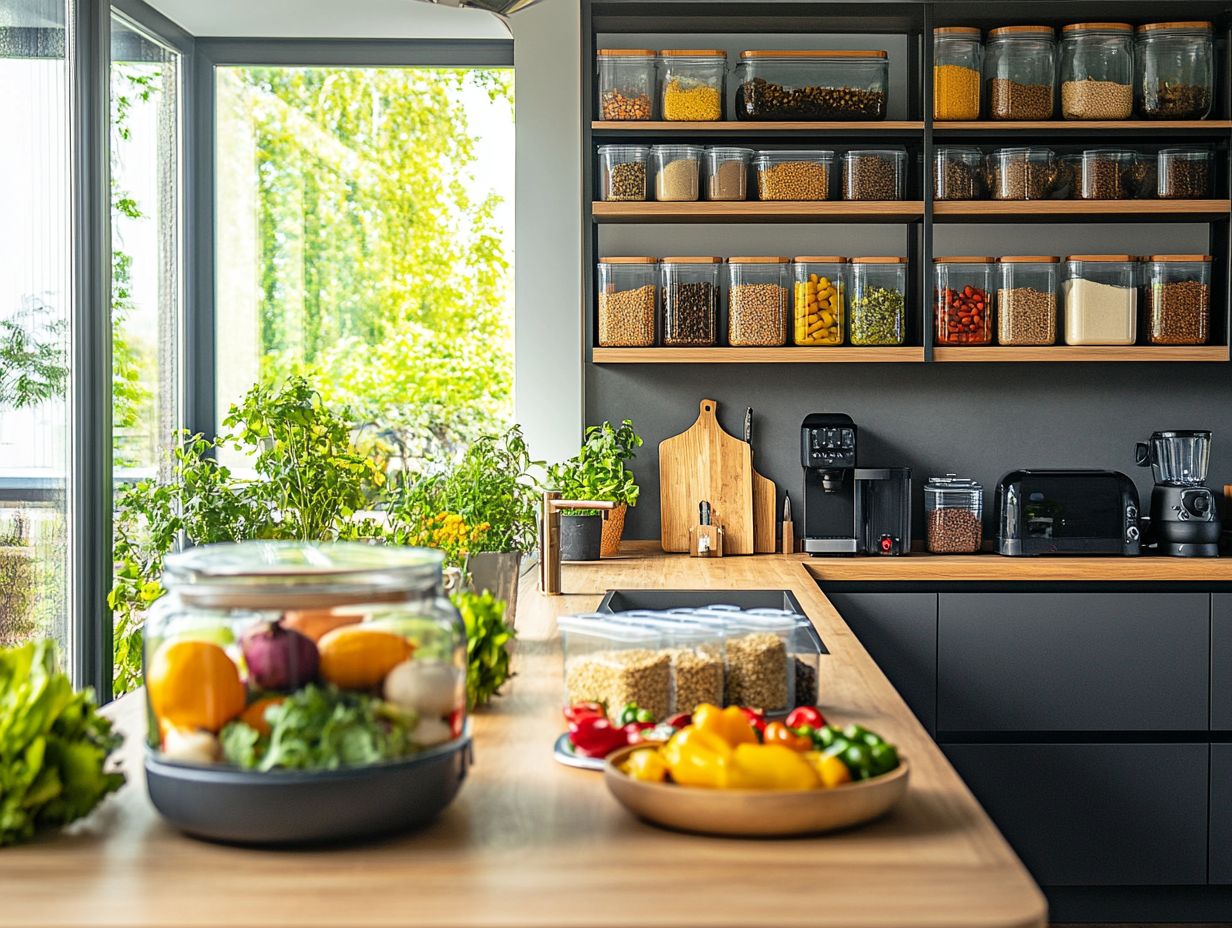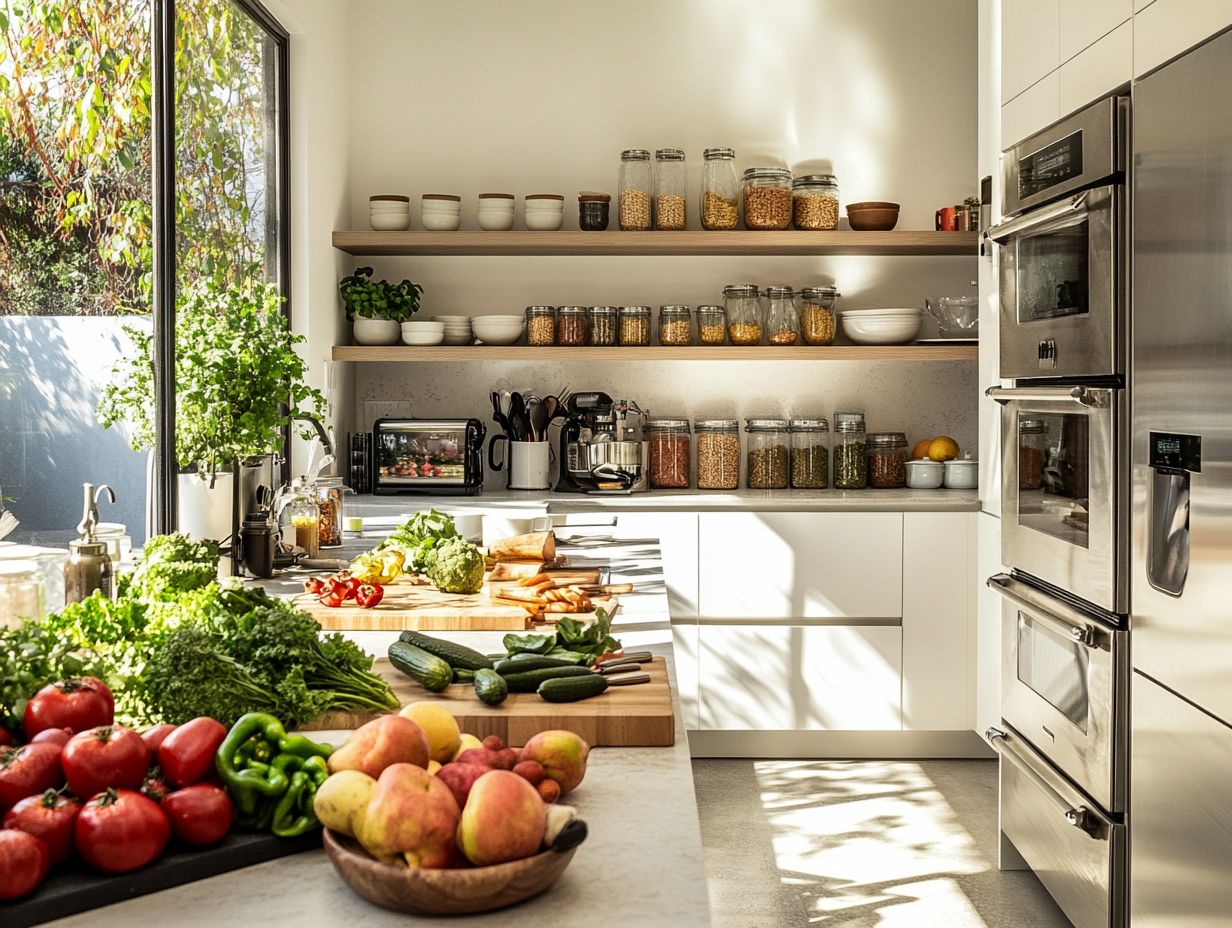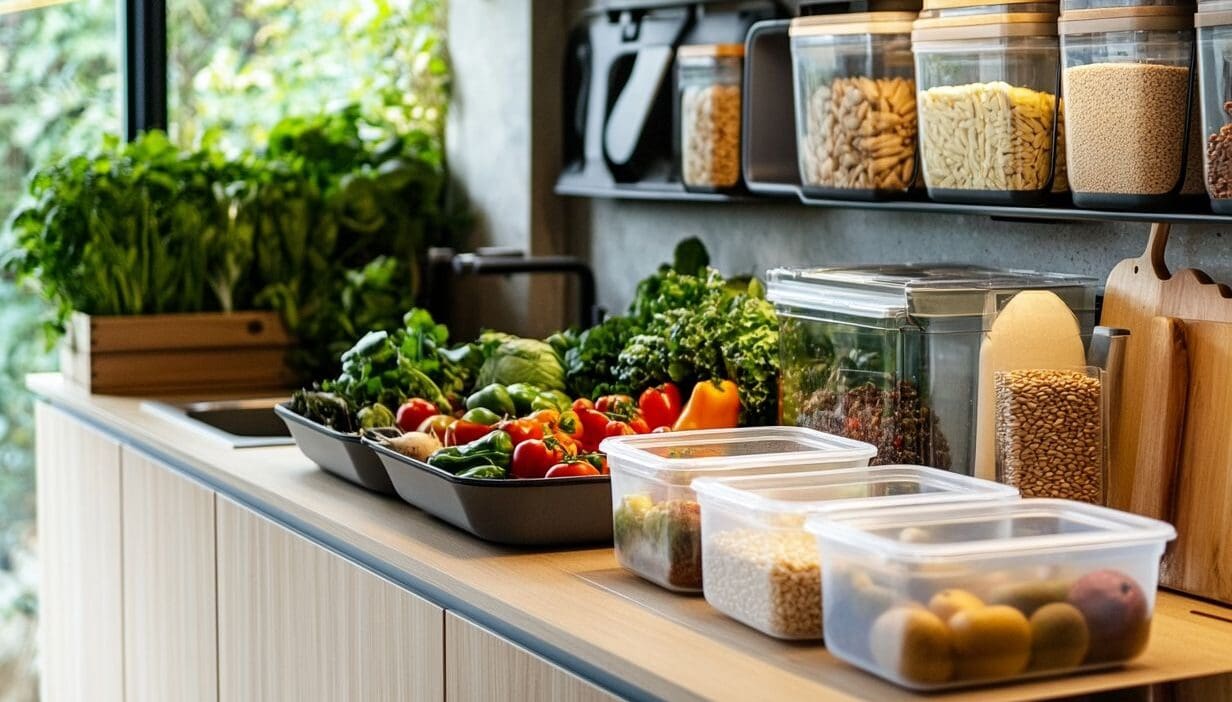In today’s fast-paced environment, maintaining a healthy lifestyle can often appear to be a challenging endeavor. Optimizing your kitchen design can significantly enhance the efficiency of meal preparation, allowing for the creation of quick and nutritious meals with greater ease, incorporating healthy eating practices such as using vegetable oil wisely. This article examines the benefits of an efficient kitchen, focusing on aspects such as smart organization, essential tools like the Moen Essie Kitchen Faucet, and the importance of stocking up on must-have ingredients. Furthermore, we will discuss strategies for seamlessly integrating exercise into your kitchen routine and sustaining healthy habits beyond meal preparation. Prepare to embrace a more efficient and health-conscious approach to daily living.
Key Takeaways:
Defining Fast, Healthy Living

Fast, healthy living embodies a proactive approach to maintaining a healthy lifestyle through optimal nutrition, meal preparation, and community-supported agriculture. The Massachusetts government provides detailed insights into how CSA farms can facilitate access to fresh produce, thereby reducing barriers to healthy eating. This approach seeks to eliminate such barriers by promoting nutrition education, advocating for home cooking, and providing access to fresh produce from farmers’ markets.
The integration of healthy food choices into daily routines not only enhances physical well-being but also fosters mental clarity and strengthens community connections. Such a holistic approach is essential in addressing the prevalence of fast food culture and encouraging a sustainable lifestyle that prioritizes both health and convenience.
Experts, including Dr. Rani Polak from Harvard Medical School, highlight the importance of cultivating healthy eating habits as a fundamental aspect of long-term well-being. Meal preparation is critical in this context, as it enables individuals to effectively plan their diets, save time, and ensure the consumption of nutritious foods.
Moreover, engagement with community initiatives can further support this lifestyle by connecting individuals with local food resources and fostering a sense of belonging. Programs that focus on Culinary Health Education enable individuals with the necessary skills to prepare healthy meals, making the pursuit of fast, healthy living both achievable and enjoyable, according to experts like Dr. Rani Polak.
This collective effort to prioritize health underscores not only personal wellness but also a community commitment to improving food environments.
Benefits of an Optimized Kitchen
An optimized kitchen is crucial for promoting a fast and healthy lifestyle, as it creates an ideal environment for meal preparation and encourages healthy eating habits.
Effective kitchen design incorporates elements that enhance efficiency, such as open shelving for easy access to ingredients and appliances that facilitate quick cooking processes. As highlighted by a recent article in Realtor Magazine, the modern kitchen is continually evolving to improve health and efficiency.
By strategically organizing a kitchen and utilizing essential tools, individuals can streamline meal preparation, making it easier to create nutritious meals, healthy snacks, and even explore indoor grilling options.
Such kitchen setups not only foster creativity in home cooking but also significantly impact the overall wellness of families and communities.
Efficiency and Health Benefits
Efficiency in the kitchen not only enhances the cooking process but also directly contributes to healthier meal choices and overall nutrition, supported by research from Healthy Eating Research – National Program Office. By implementing effective meal planning strategies, families can ensure a balanced diet that includes whole grains, fruits, and vegetables, which are essential for optimal health.
Cooking techniques that focus on time-saving methods enable individuals to prepare nutritious meals without feeling overwhelmed, thereby reducing the likelihood of resorting to fast food options. Through nutrition education and practical cooking methods, individuals are enableed to take control of their diets and make informed food choices that promote longevity and well-being.
Dr. Rani Polak, a distinguished faculty member at Harvard Medical School, underscores the importance of creating a well-organized kitchen to significantly enhance one’s ability to cook wholesome meals. Simple actions, such as preparing ingredients in advance and designating specific cooking nights, can streamline the process and alleviate stress.
Utilizing tools such as meal prep containers and shopping lists not only saves time but also maintains a clear focus on nutritious options. This structured approach not only fosters healthier eating habits but also cultivates a family environment conducive to shared meals, promoting a lifestyle rooted in wellness and community cohesion.
Key Elements of an Optimized Kitchen

An optimized kitchen is defined by essential elements that enhance functionality and facilitate the efficient preparation of healthy meals, inspired by principles from the Institute of Lifestyle Medicine.
Effective kitchen design prioritizes organization and layout, ensuring that ingredients and tools are readily accessible, thereby streamlining meal preparation and minimizing cooking time.
Furthermore, the inclusion of essential tools and appliances, such as air fryers and high-quality Stainless Steel pots and pans, substantially improves the overall cooking experience.
This deliberate approach to kitchen organization not only supports rapid meal preparation but also encourages a creative environment conducive to consistently producing nutritious dishes.
Organization and Layout
The organization and layout of a kitchen are fundamental in facilitating an efficient cooking environment, thereby enabling seamless meal preparation and the creation of healthy dishes. By implementing kitchen design strategies, such as open shelving, individuals can readily access ingredients and tools, thereby reducing the time spent searching for items.
A well-structured kitchen promotes the use of fresh produce and healthier food choices, fostering a lifestyle centered around nutrition and wellness. A thoughtfully designed layout not only enhances the cooking experience but also stimulates creativity in meal preparation.
The arrangement of appliances and workstations significantly impacts how individuals engage with their cooking space. For example, positioning frequently used items within arm’s reach can streamline food preparation, a principle emphasized by the Institute of Lifestyle Medicine’s focus on effective kitchen layouts.
This approach not only conserves time but also diminishes the temptation to opt for unhealthy alternatives, thereby reinforcing healthy eating habits. According to Culinary Health Education Fundamentals, an inviting kitchen encourages home cooking, resulting in more nutritious meals tailored to individual dietary preferences.
Consequently, prioritizing an efficient kitchen design is essential for anyone aiming to cultivate a healthier lifestyle.
Essential Tools and Appliances
Possessing the appropriate essential tools and appliances in the kitchen is crucial for achieving efficient and healthy meal preparation.
Each tool plays a significant role in streamlining the cooking process, enabling a range of healthy cooking methods. For example, a dependable blender can effortlessly produce smoothies rich in fruits and vegetables, while food processors are capable of chopping, slicing, and dicing ingredients, thereby saving valuable time.
Slow cookers and Instant Pots serve as invaluable resources for individuals with busy schedules, as they facilitate meal planning through one-pot cooking that preserves nutrients and flavors.
Investing in high-quality kitchen gadgets not only fosters culinary creativity but also guarantees that meals are both flavorful and abundant in essential nutrients, which is vital for maintaining a balanced and health-conscious diet.
Stocking Your Kitchen for Fast, Healthy Meals

Stocking the kitchen with appropriate ingredients is essential for preparing quick, healthy meals that contribute to a balanced diet.
Key items such as fresh fruits and vegetables, whole grains, nuts, and seeds should be considered staples in every kitchen to facilitate nutritious meal preparation.
By concentrating on essential ingredients, individuals can enhance their meal planning process, making it more efficient to prepare healthy snacks and meals that are both flavorful and satisfying.
A well-stocked kitchen also minimizes reliance on fast food options, thereby promoting healthier food choices overall, and encourages the use of a water filter for clean cooking water.
Must-Have Ingredients
Incorporating essential ingredients into the kitchen is crucial for preparing healthy meals and snacks that promote overall wellness. Staples such as fresh fruits and vegetables, whole grains, nuts, and seeds not only enhance the nutritional quality of various dishes but also provide essential vitamins and minerals necessary for optimal health.
By ensuring that these ingredients are readily available, home cooks can easily integrate them into their meals and snacks, thereby making healthy eating a convenient and accessible option. This proactive approach to kitchen stocking fosters a commitment to nutrition and encourages the adoption of a healthier lifestyle.
Specific items, including leafy greens, berries, quinoa, and legumes, should be prioritized due to their versatility and health benefits.
- Leafy greens such as spinach and kale are rich in iron and folate, making them ideal for salads or smoothies. Additionally, they can be featured in recipes like Zucchini and Mint Soup.
- Berries, known for their high antioxidant content, can enhance breakfast bowls or be blended into delightful desserts. They can also be found at local farmers markets, ensuring fresh and nutritious options.
- Quinoa provides an excellent foundation for grain salads and is rich in protein, serving as a commendable alternative to refined grains.
- Legumes, including beans and lentils, offer significant fiber content and can be easily incorporated into soups, stews, or even transformed into spreads. These legumes also align well with the principles of Healthy Eating Research.
This strategy not only enables individuals to create a variety of nutritious meals but also facilitates the maintenance of a balanced diet that supports a vibrant lifestyle. Moreover, exploring Culinary Health Education can significantly enhance one’s cooking skills.
Meal Planning and Preparation Tips
Effective meal planning and preparation strategies can significantly enhance one’s ability to create healthy meals while minimizing stress and time spent in the kitchen.
By implementing a few key strategies, individuals can transform their cooking routines into efficient and enjoyable processes. For instance, establishing a weekly meal schedule not only aids in organizing grocery lists but also alleviates the last-minute scramble for dinner ideas.
Investing in high-quality containers for meal storage facilitates easy access to prepped ingredients and leftovers, ensuring that nutritious options are consistently available. Additionally, incorporating versatile ingredients such as whole grains, lean proteins, and a variety of colorful vegetables can lead to diverse and satisfying meals. Incorporating community supported agriculture can further promote access to fresh, quality ingredients.
Furthermore, embracing batch cooking on weekends can save time during busy weekdays, enabling individuals to nourish themselves and their families without the burden of daily meal preparation. For instance, investing in high-quality Pots and Pans can streamline the cooking process.
Incorporating Exercise into Your Kitchen Routine

Incorporating exercise into one’s kitchen routine can significantly enhance an overall healthy lifestyle by merging physical activity with daily cooking tasks. This fusion of activities is advocated by experts like Dr. Rani Polak. Even something as simple as installing a Moen Essie Kitchen Faucet can make kitchen chores more efficient.
Simple kitchen workouts or stretching exercises can be seamlessly integrated during meal preparation, promoting movement and mitigating sedentary behavior. This practice can be further supported by tools and insights from the Institute of Lifestyle Medicine.
By implementing exercise strategies that encourage brief bursts of activity throughout cooking sessions, individuals can improve their fitness levels while simultaneously preparing nutritious meals.
This holistic approach emphasizes the importance of physical fitness and aligns with nutrition education principles that advocate for a balanced and active lifestyle.
Kitchen Workouts and Tips
Kitchen workouts present an innovative approach to incorporating physical activity into daily routines while engaging in meal preparation.
These dynamic exercises not only promote movement but also enhance the overall cooking experience, making it more energetic and enjoyable. This approach is part of the Culinary Health Education Fundamentals.
For example, while stirring a pot, performing calf raises can improve muscle tone in the legs, and executing lunges while retrieving ingredients can enhance balance and coordination.
By adopting these movements, individuals can transform routine tasks into fitness opportunities, enabling them to burn calories and tone muscles without requiring additional time allocated for workouts. For example, brands like Bionic Health provide tips for integrating fitness into daily life.
This holistic approach underscores the importance of seamlessly integrating healthy habits into everyday life, ensuring that cooking nourishes the body not only through food but also through physical activity.
Maintaining a Fast, Healthy Lifestyle Beyond the Kitchen
Maintaining a fast and healthy lifestyle involves more than just dietary choices; it necessitates the incorporation of healthy habits into everyday routines. This is supported by research and guidelines from Harvard Medical School. This includes making informed decisions about nutrition, participating in regular physical activity, and supporting community-based agricultural initiatives to obtain fresh produce.
Nutrition education is essential in equipping individuals with the knowledge of healthy eating practices and the significance of balanced diets. By cultivating a culture that prioritizes well-being, individuals can sustain their healthy lifestyles while positively contributing to their communities.
Incorporating Healthy Habits into Daily Life
Incorporating healthy habits into daily life is essential for maintaining a fast-paced, healthy lifestyle and achieving long-term wellness. This can include straightforward changes such as prioritizing nutrient-rich foods in meal preparation, employing effective cooking techniques to prepare healthy meals efficiently, and making informed decisions based on nutrition education. Engaging with community-supported agriculture further promotes healthy food choices by providing access to fresh, seasonal produce. Additionally, supporting compost initiatives can help maintain a sustainable kitchen environment.
By consistently integrating these habits into their daily routines, individuals can establish a sustainable path toward improved health and well-being. Engaging in programs from the Institute of Lifestyle Medicine can also be beneficial.
To start, individuals may consider planning their meals for the week, with an emphasis on incorporating a diverse range of whole grains, lean proteins, and colorful fruits and vegetables.
Exploring new recipes can enhance the cooking experience and foster creativity in the kitchen. Participating in nutrition workshops or cooking classes can further augment one’s knowledge and skills, enableing individuals to make healthier choices. Participating in initiatives like Natural Kitchen workshops can further enhance one’s ability to prepare nutritious meals.
Implementing practical strategies such as batch cooking or preparing ingredients on weekends can ensure that nutritious meals are readily available during busy weekdays. Additionally, engaging with local health communities can provide support and motivation, promoting a stronger commitment to wellness.



